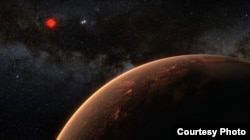Last week's announcement of the discovery of an earthlike planet just 4.2 light years away put astronomy on the front page, drowning out - if just for a moment - the unceasing political barrage of a U.S. election year.
But beyond the headlines, we wanted to take readers back to Proxima b, the earthlike planet orbiting Proxima Centauri to see if we might one day call this rocky exoplanet home.
Well, it's a great location, location, location!
Part of what makes the discovery of Proxima b so special is that it's small. Taking the word "easy" with a planet sized grain of salt, it's become fairly easy for astronomers to find gas giants like Jupiter and Saturn out there in our galaxy. The problem is that gas giants, with their crushing gravity and noxious vapors, may not be conducive to life, and certainly not life as we know it.
The discovery of a rocky planet about the size of Earth, with a temperature that allows for water in its liquid state, makes life much more possible, and perhaps inevitable. Plus, it's so close the possibility of us visiting becomes conceivable, if unlikely.
So, it looks like Earth, it feels like Earth, it could be wet like Earth. Could we live there? And the more existential question: is finding another earth not just exciting, but necessary? Is finding a new home, as Isaac Asimov once said, "the only chance of escaping what is otherwise the sure destruction of all that humanity has struggled to achieve?"
Well, when you put it that way...
So is this the one?
But gathering the thoughts of astronomers since last week, it turns out Proxima b may not make the grade.
At the University of Washington (UW), a team of "astronomers, geophysicists, climatologists, evolutionary biologists" form what is called the Virtual Planetary Laboratory (VPL). The team's goal is to study "how distant planets might host life."
So what is their take on Proxima b? According to Rory Barnes, a UW astronomer, "It's complicated."
Here are a few of the factors that make Proxima b complicated, when it comes to colonization: orbit, temperature and spin.
Close to you
The planet is only seven million kilometers from its star, Proxima Centauri. In comparison, Earth orbits about 148 million kilometers out from the Sun. That puts Proxima b on its star's doorstep. Any solar hiccups, flares, or coronal mass ejections are likely to hit Proxima b head on.
That kind of routine radiation bath would be distinctly bad for us humans, and Proxima Centauri flares much more often than our Sun.
It's hot in here
Another problem is that Proxima Centauri wasn't always the small, cool, red dwarf it is today. Barnes explains: "for the first one billion years, Proxima slowly dimmed to its current brightness, which implies that for about the first quarter of a billion years, planet b’s surface would have been too hot for Earth-like conditions.”
The analogy is that for a really long time, Proxima b might have looked like Venus, our solar system's poster child planet for the runaway greenhouse effect. UW graduate student Rodrigo Luger says heat like that "can destroy all of the planet’s primordial water."
That makes it less likely the planet would support life, and much more difficult for us to colonize if we were to visit.
You only see one side of me
Another problem is that with its short 11 day orbit, Proxima b may be tidally locked. That means the same side of the planet faces its sun at all times.
And while astronomers think wind can disperse some of that constant daytime heat around the planet, tidal locking is problematic when it comes to making things easy for life to take hold.
Hope springs eternal
While that reads like mostly bad news, the research on Proxima b is just getting underway and the news has put a lot of eyes on this rocky second Earth.
New research and new techniques will soon be searching for hints of oxygen in the planet's atmosphere, and for chemicals in the atmosphere that point to hints of life.
Victoria Meadows, the principal investigator at VPL, told VOA "The hope is that we can do "comparative planetology" and learn about the histories and environments of planets in other planetary systems."
She says she believes that finding life beyond our solar system is likely within the next two generations. "I'm cautiously optimistic that we will find life beyond the Earth in my lifetime, and if not, in my students' lifetimes."
Barnes is also optimistic about finding life, and about the potential for finding a new home in the stars.
"It might be an ideal place to move," he says. "Perhaps we have just discovered a future home for humanity. But in order to know for sure, we must make more observations, run many more computer simulations and, hopefully, send probes to perform the first direct reconnaissance of an exoplanet.”











